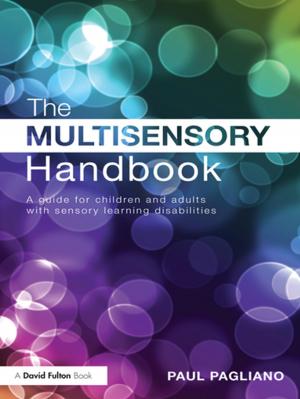| Author: | Johannella Tafuri | ISBN: | 9781351562867 |
| Publisher: | Taylor and Francis | Publication: | July 5, 2017 |
| Imprint: | Routledge | Language: | English |
| Author: | Johannella Tafuri |
| ISBN: | 9781351562867 |
| Publisher: | Taylor and Francis |
| Publication: | July 5, 2017 |
| Imprint: | Routledge |
| Language: | English |
What can infants hear? What are their reactions to music? Is it useful for them to sing and listen to music? Is their auditory sensitivity developed before their birth? At what age do they start singing, and clapping their hands? How can their musical development be improved? These (and other) questions are present in today's debate on music education and the responses are normally given in an intuitive way. It is now necessary and urgent to sketch a developmental profile of infants, starting from their earliest manifestations. In the last 30 years, research in this field has been progressively developed. In most cases research has been devoted to single aspects of more complex problems. Moreover, it has been based on non-homogeneous categories of subjects and by different methods. Motivated by the fact that many open problems need to be solved, Professor Tafuri decided, in 1998, to begin a longitudinal research project devoted to studying the musical development in children from 0 to 6 years, with particular attention on the ability to sing in tune. During these 6 years, the children would have a regular music education experience with their mothers and often other members of the immediate family. This book has two main areas of focus. The first reconstructs the development of human musical abilities. Tafuri systematically reports studies of the development of vocal, rhythmic and motor abilities through the observation of the same participants for three years, beginning with the mothers' experiences in the last three months of pre-natal life. The programme of musical activities and the modalities of the collaboration with the parents are described. The second area of focus puts forward an educational perspective based on the results of the research. The amount and the quality of the collected data can allow parents and educators to plan different activities by considering the starting point for individual participants and the development of the
What can infants hear? What are their reactions to music? Is it useful for them to sing and listen to music? Is their auditory sensitivity developed before their birth? At what age do they start singing, and clapping their hands? How can their musical development be improved? These (and other) questions are present in today's debate on music education and the responses are normally given in an intuitive way. It is now necessary and urgent to sketch a developmental profile of infants, starting from their earliest manifestations. In the last 30 years, research in this field has been progressively developed. In most cases research has been devoted to single aspects of more complex problems. Moreover, it has been based on non-homogeneous categories of subjects and by different methods. Motivated by the fact that many open problems need to be solved, Professor Tafuri decided, in 1998, to begin a longitudinal research project devoted to studying the musical development in children from 0 to 6 years, with particular attention on the ability to sing in tune. During these 6 years, the children would have a regular music education experience with their mothers and often other members of the immediate family. This book has two main areas of focus. The first reconstructs the development of human musical abilities. Tafuri systematically reports studies of the development of vocal, rhythmic and motor abilities through the observation of the same participants for three years, beginning with the mothers' experiences in the last three months of pre-natal life. The programme of musical activities and the modalities of the collaboration with the parents are described. The second area of focus puts forward an educational perspective based on the results of the research. The amount and the quality of the collected data can allow parents and educators to plan different activities by considering the starting point for individual participants and the development of the















